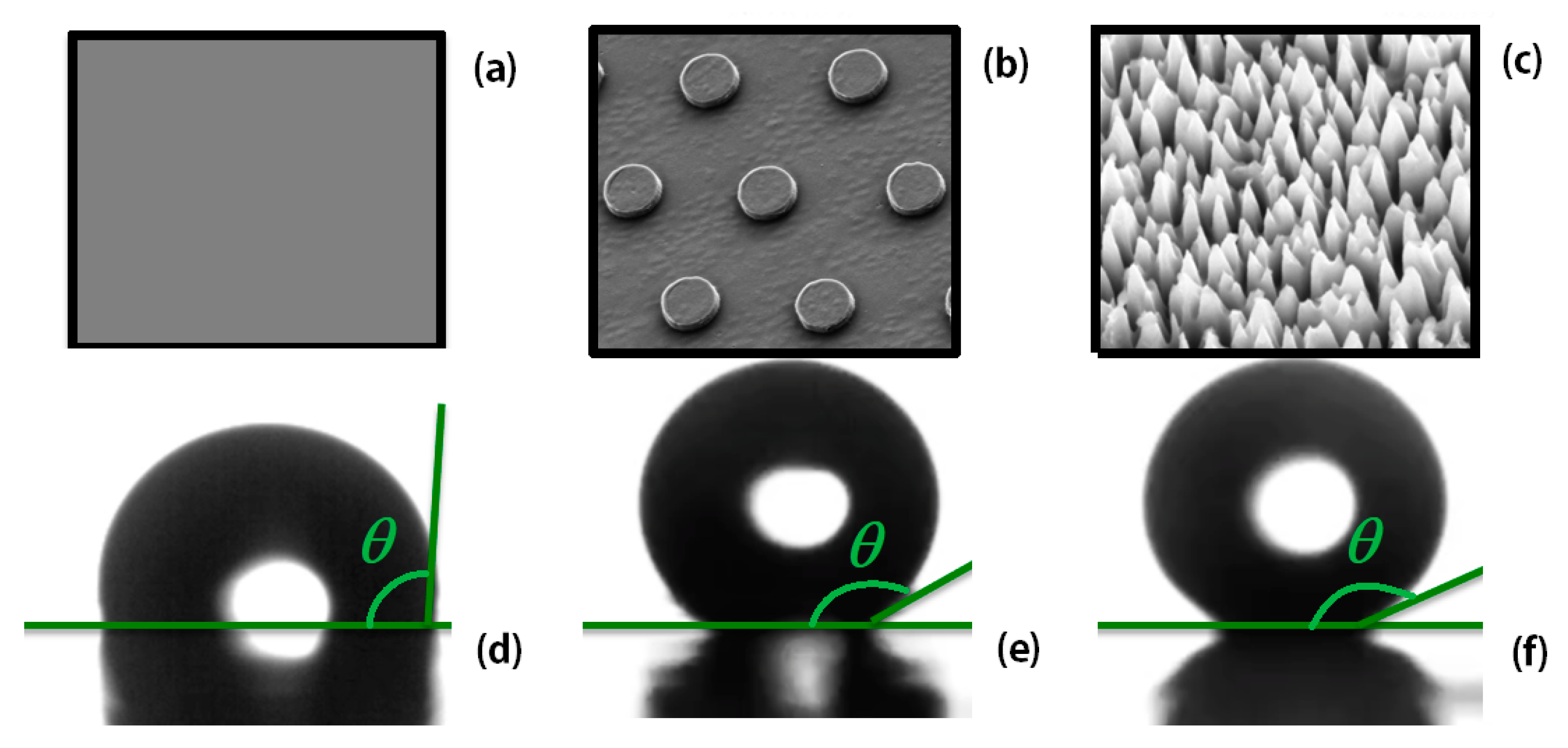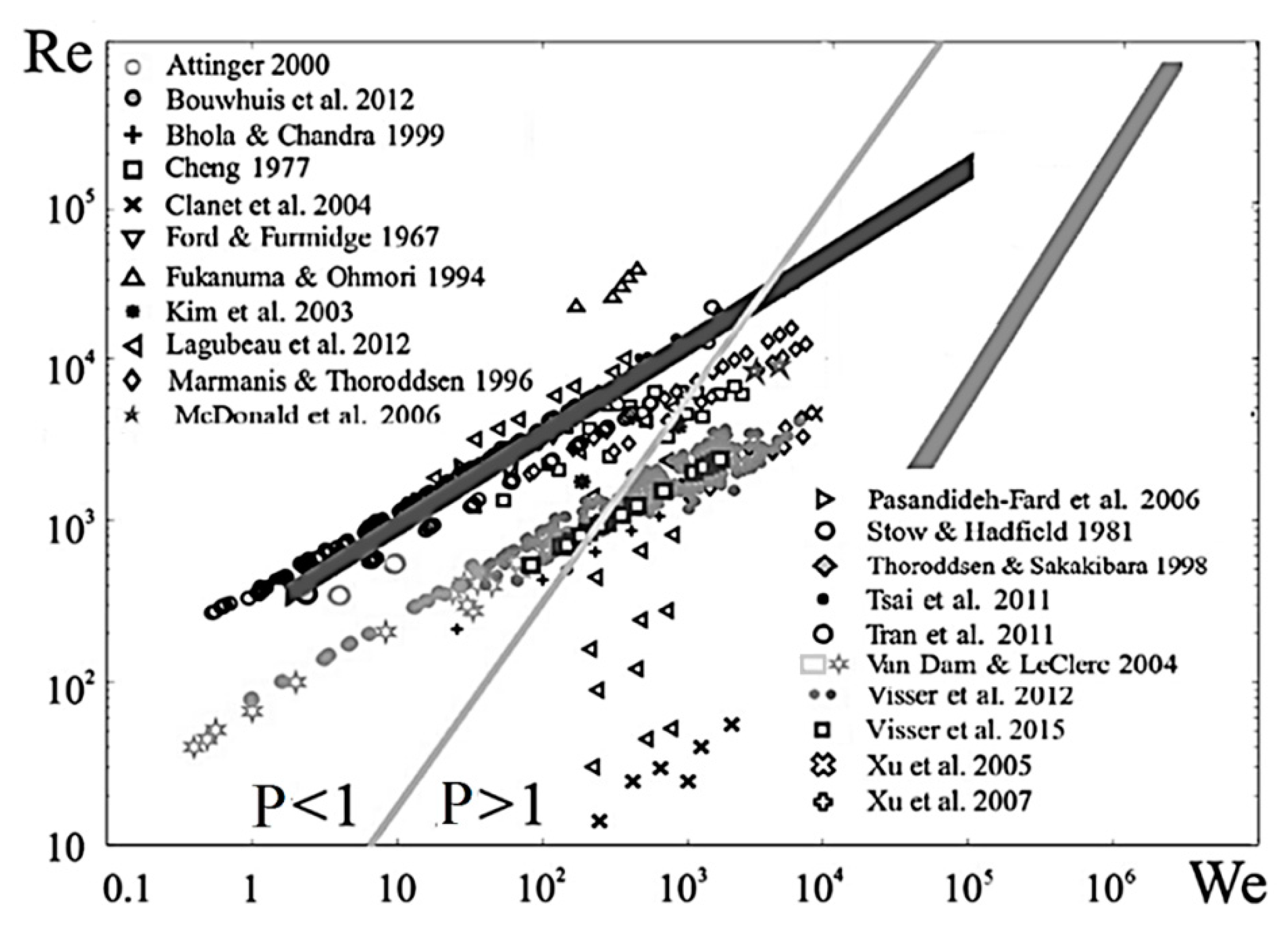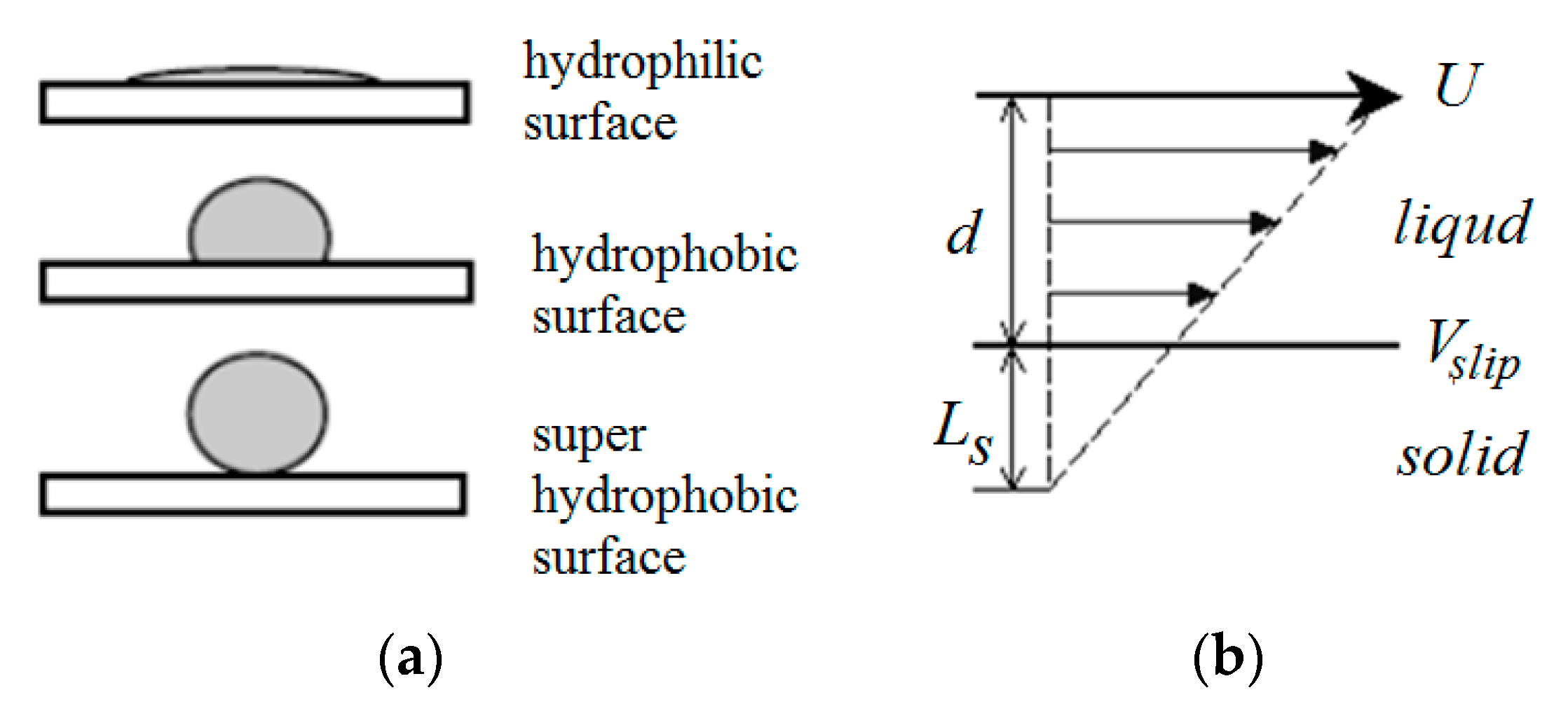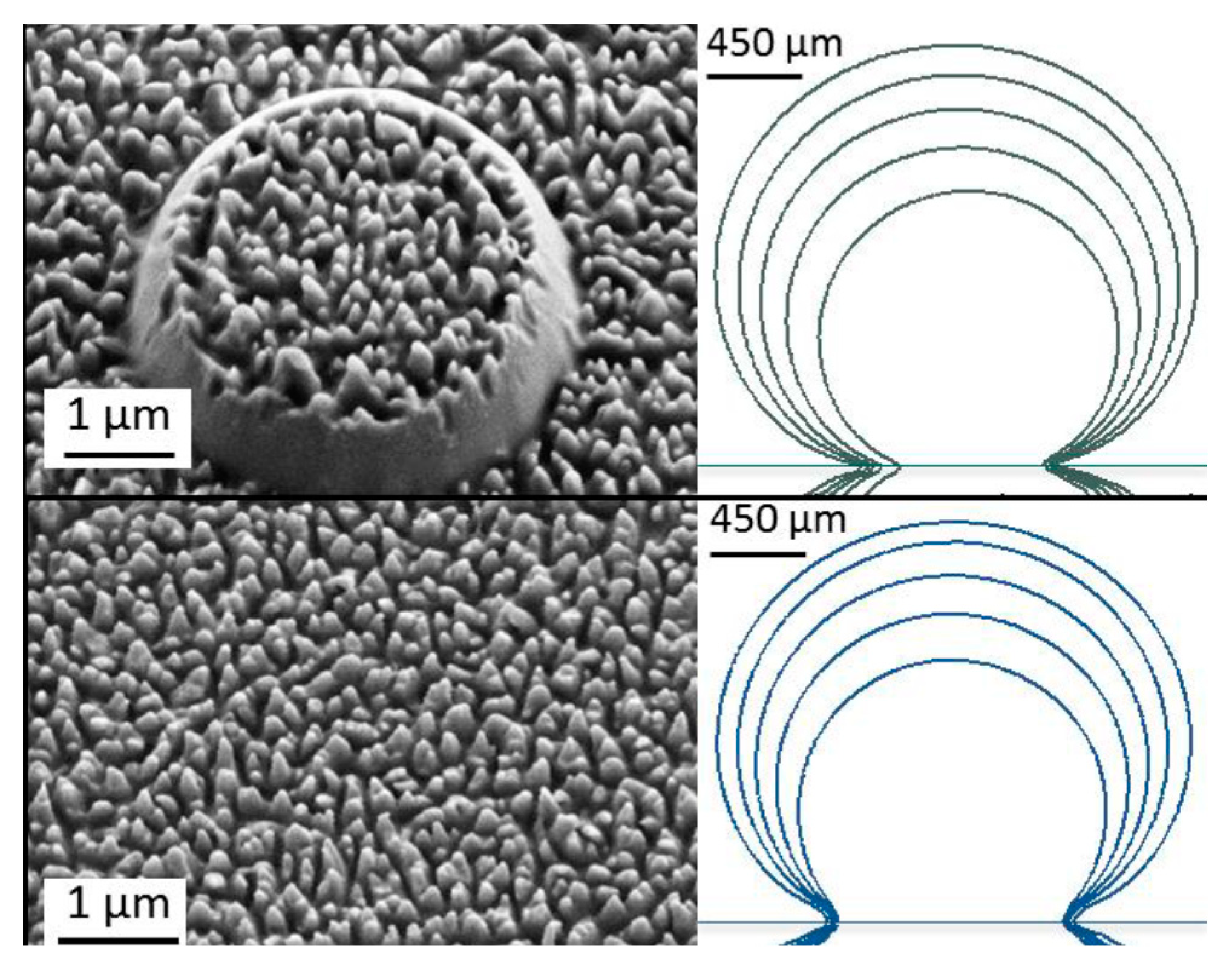Physical De-Icing Techniques for Wind Turbine Blades †
Abstract
:1. Introduction
2. De-Icing Techniques for Wind Turbine Blades
- In general, the operation of wind turbines depends on the natural conditions in the surface atmosphere, which is the lower part of the atmospheric boundary layer (ABL). The dynamics of ABL, through which energy and mass transfer (which determines, in particular, heat fluxes, and moisture flows) between the earth’s surface and the free atmosphere occurs, is determined by many factors, such as topographic relief, daily temperature fluctuations, etc. The complex processes of energy and mass exchange in ABL exist in the Arctic regions along the coastline where air flows are influenced by different conditions on land and over the sea surface with the unfrozen sections of water–shore ice openings [30,31,32].Due to the difference between air and water temperatures, heat fluxes in such places increase by orders of magnitude. A sharp vertical temperature gradient leads to a significant circulation of air masses in the ABL [30,31,32,33,34], and changes the wind direction and strength, providing conditions for the efficient operation of wind farms in the coastal zone of the Arctic seas. The presence of open areas of water also changes the air conditions. This factor is accompanied by the formation of an ice coat on the surface of the wind turbine blades, which complicates the operation of wind farms in northern latitudes and makes the problem of the icing of equipment and rotors of wind turbines very relevant.It is necessary to control the accumulation of ice and prevent its impact on the operation of turbines. When designing a wind turbine, natural conditions affecting the icing of the blades should be taken into account. The challenge to the optimal operation of the Arctic wind turbines is icing. The authors of [11] note that one option that has not received much attention is airfoil pitch control. Nonetheless, several studies with intelligent algorithms for wind turbine operations [13,14] have shown that the optimal airfoil angle of attack can reduce icing by using the pitch differently during normal and icing operation modes.The work [11] presents an advanced intelligent automatic control system by the pitch variation in the icing condition. This article shows the effect of using turbine control to reduce icing by 2–5%. Among the simple airfoil modifications reducing ice, there is a change of the surface shape by different riblets designed for the cable case [6].
- Most mature active anti-ice technologies use blade heating to prevent icing due to freezing [22]. The development of thermal heating systems to combat icing occurs mainly due to the creation of new electric heaters in the form of built-in thin elastic plates or systems of conductive materials and coatings [35]. The heaters are mounted on the blade surface sections subjected to freezing (as a rule, the nasal parts of blades) and are switched on following the icing sensor signals. A surface heating technique for polymeric materials of the blade was developed in [36].However, the author of [9] indicated the main disadvantage of the method, i.e., the energy-consuming heat generation. In addition, the electric anti-icing technology uses a thermal pad and a foil on the blade surface, which changes the aerodynamic capacity of the blade and reduces its performance [37]. The authors of [38] proposed a method for comparing and evaluating two strategies for mitigating the effects of icing: reduction of the nominal characteristics of the gear ratio and electrothermal anti-icing. This method considers the accumulated ice mass, net energy losses during and after icing, and financial break-even points. The results show that, in some cases, derating [39] may be preferable to electrothermal protection.
- The authors of [9] called the ultrasonic technology a new type of ice protection, and tested it in different areas before its use for the de-icing of blades. The development of systems of ultrasonic de-icing is on the way to creating ultrasonic waves supply at the interface between the surface and the ice. The waves of a fixed frequency cause the destruction and removal of ice from solid surfaces. The principle of this technique is to form shear stress between the ice and the wing or rotor surfaces [40,41]. Many researchers have measured the ice adhesion to aluminum at different temperatures for aircraft purposes [42,43]. The authors of [9] hope that these data will help de-icing in wind turbine blades. The adhesion of ice depends on the contact zone of the ice and the blade, the material of the surface roughness, the temperature, and other factors. Indeed, if the resultant force is greater than the adhesion of the ice, the latter will fall off.Other methods of de-icing are combined ultrasonic and low-frequency vibration [44] or ultrasound and low-frequency vibration to increase its effectiveness on the blades [45]. The vibration impact systems are based on the principle of oscillatory action on the blade. In [9], many scholars are mentioned to have proven the effectiveness of the ultrasonic de-icing method. This method is superior to other methods with much lower energy consumption. Unfortunately, due to the late application of ultrasonic technology on blades of the wind turbine, the technology is not yet sufficiently mature.Another technique generates heat by transmitting microwave electromagnetic energy to the surface of the rotor blade to prevent ice formation [26,27]. The blade surface is protected by a dielectric coating that increases the reflection of the microwave energy. The heat generated by microwave energy weakens the ice formation and ice adhesion when a supercooled rain droplet collides with the blade surface. The dissemination of transmitted microwave electromagnetic energy into the dielectric material is designed to ensure the necessary amount of thermal energy during suitable heating time to warm supercooled water droplets above the freezing point when they collide with the blade surface. The appropriate selection of both the thickness of the dielectric coating and the microwave frequency plays a significant role in improving the performance of the technique.
- A popular solution to combat icing from equipment today is a superhydrophobic coating. Indeed, this type of coating on the rotor blades prevents water adsorption on the surface and icing on the blades. There are numerous research works on this issue, as reported in the last reviews [9]. Thus, this will be the subject of the next section.
3. Protection against Icing by a Hydrophobic Material
- The hydrophobic coating should effectively reduce the formation of ice and snow.
- The production of the coating should be simple, cheap, and environmentally friendly.
- The coating material should be easily mounted or applied to the blade of a wind turbine.
- This material must be durable to withstand the weather conditions of the Arctic coast. To this end, it must be well tested in a climatic wind tunnel to meet the weather conditions typical for the Arctic coast.
4. Conclusions
- -
- a promising and rapidly developing direction with the use of intelligent technologies that reduce icing by selecting operating modes taking into account climatic conditions and other external energy sources in real-time;
- -
- traditional active ice removal technologies: heating, vibration, ultrasonic exposure, and their combinations; and
- -
- passive methods of de-icing.
Author Contributions
Funding
Institutional Review Board Statement
Informed Consent Statement
Data Availability Statement
Acknowledgments
Conflicts of Interest
References
- BTM World Market Update 2012. Navigant Research 2013. Available online: https://www.businesswire.com/news/home/20130326005329/en/Navigant-Research-Releases-New-BTM-Wind-Report-World-Market-Update-2012 (accessed on 26 March 2013).
- Elistratov, V.; Kudryashova, I.; Pilipets, P. Energy efficient solutions of power supply in north regions. Appl. Mech. Mater. 2015, 725, 559–568. [Google Scholar] [CrossRef]
- Osintsev, K.; Aliukov, S.; Shishkov, A. Improvement dependability of offshore horizontal-axis wind turbines by applying new mathematical methods for calculation the excess speed in case of wind gusts. Energies 2021, 14, 3085. [Google Scholar] [CrossRef]
- Liu, Y.; Li, Q.; Farzaneh, M.; Du, B.X. Image characteristic extraction of ice-covered outdoor insulator for monitoring icing degree. Energies 2020, 13, 5305. [Google Scholar] [CrossRef]
- Rastayesh, S.; Long, L.; Dalsgaard Sørensen, J.; Thöns, S. Risk assessment and value of action analysis for icing conditions of wind turbines close to highways. Energies 2019, 12, 2653. [Google Scholar] [CrossRef] [Green Version]
- Demartino, C.; Koss, H.H.; Georgakis, C.T.; Ricciardelli, F. Effects of ice accretion on the aerodynamics of bridge cables. J. Wind Eng. Ind. Aerodyn. 2015, 138, 98–119. [Google Scholar] [CrossRef]
- Gantasala, S.; Tabatabaei, N.; Cervantes, M.; Aidanpää, J.-O. Numerical investigation of the aeroelastic behavior of a wind turbine with iced blades. Energies 2019, 12, 2422. [Google Scholar] [CrossRef] [Green Version]
- Turkia, V.; Huttunen, S.; Thomas, W. Method for Estimating Wind Turbine Production Losses Due to Icing; VTT Technical Research Centre of Finland: Espoo, Finland, 2013. [Google Scholar]
- Wei, K.; Yang, Y.; Zuo, H.; Zhong, D. A review on ice detection technology and ice elimination technology for wind turbine. Wind Energy 2020, 23, 433–457. [Google Scholar] [CrossRef]
- Kazem, H.A.; Al-Badi, H.A.S.; Al Busaidi, A.S.; Chaichan, M.T. Optimum design and evaluation of hybrid solar/wind/diesel power system for Masirah Island. Environ. Dev. Sustain. 2017, 19, 1761–1778. [Google Scholar] [CrossRef]
- Elistratov, V.; Konishchev, M.; Denisov, R.; Bogun, I.; Grönman, A.; Turunen-Saaresti, T.; Lugo, A.J. Study of the intelligent control and modes of the arctic-adopted wind–diesel hybrid system. Energies 2021, 14, 4188. [Google Scholar] [CrossRef]
- Janzon, E.; Körnich, H.; Arnqvist, J.; Rutgersson, A. Single column model simulations of icing conditions in northern Sweden: Sensitivity to surface model land use representation. Energies 2020, 13, 4258. [Google Scholar] [CrossRef]
- Yang, X.; Ye, T.; Wang, Q.; Tao, Z. Diagnosis of blade icing using multiple intelligent algorithms. Energies 2020, 13, 2975. [Google Scholar] [CrossRef]
- Molinder, J.; Scher, S.; Nilsson, E.; Körnich, H.; Bergström, H.; Sjöblom, A. Probabilistic forecasting of wind turbine icing related production losses using quantile regression forests. Energies 2021, 14, 158. [Google Scholar] [CrossRef]
- Etemaddar, M.; Hansen, M.O.L.; Moan, T. Wind turbine aerodynamic response under atmospheric icing conditions. Wind Energy 2014, 17, 241–265. [Google Scholar] [CrossRef]
- Villalpando, F.; Reggio, M. Prediction of ice accretion and anti-icing heating power on wind turbine blades using standard commercial software. Energy 2016, 114, 1041–1052. [Google Scholar] [CrossRef]
- Shu, L.; Qiu, G. Numerical and experimental investigation of threshold de-icing heat flux of wind turbine. J. Wind. Eng. Ind. Aerodyn. 2018, 174, 296–302. [Google Scholar] [CrossRef]
- Hu, L.; Zhu, X. Wind turbines ice distribution and load response under icing conditions. Renew. Energy 2017, 113, 608–619. [Google Scholar] [CrossRef]
- Shu, L.; Li, H. Study of ice accretion feature and power characteristics of wind turbines at natural icing environment. Cold Reg. Sci. Technol. 2018, 147, 45–54. [Google Scholar] [CrossRef]
- Parent, O.; Ilinca, A. Anti-icing and de-icing techniques for wind turbines: Critical review. Cold Reg. Sci. Technol. 2011, 65, 88–96. [Google Scholar] [CrossRef]
- Habibi, H.; Edwards, G. Modelling and empirical development of an anti/de-icing approach for wind turbine blades through superposition of different types of vibration. Cold Reg. Sci. Technol. 2016, 128, 1–12. [Google Scholar] [CrossRef] [Green Version]
- Batisti, L. Green Energy and Technology. Icing Impacts and Mitigation System; Springer: Cham, Switzerland, 2015; p. 355. ISSN 1865-3529. [Google Scholar]
- Wang, Y.; Xu, Y.; Huang, Q. Progress on ultrasonic guided waves de-icing techniques in improving aviation energy efficiency. Renew. Sustain. Energy Rev. 2017, 83, 638–645. [Google Scholar] [CrossRef]
- Wang, Y.; Xu, Y. An effect assessment and prediction method of ultrasonic de-icing for composite wind turbine blades. Renew. Energy 2018, 118, 1015–1023. [Google Scholar] [CrossRef]
- Wang, Z. Recent progress on ultrasonic de-icing technique used for wind power generation, high-voltage transmission line and aircraft. Energy Build 2017, 140, 42–49. [Google Scholar] [CrossRef]
- Madi, E.; Pope, K.; Huang, W.; Iqbal, K. A review of integrating ice detection and mitigation for wind turbine blades. Renew. Sustain. Energy Rev. 2019, 103, 269–281. [Google Scholar] [CrossRef]
- Ilinca, A. Analysis and mitigation of icing effects on wind turbines. In Wind Turbines; Al-Bahadly, I., Ed.; In Tech: Rijeka, Croatia, 2011; p. 177. [Google Scholar] [CrossRef] [Green Version]
- Sojoudi, H.; Wang, M.; Boscher, N.D.; McKinley, G.H.; Gleason, K.K. Durable and scalable icephobic surfaces: Similarities and distinctions from superhydrophobic surfaces. Soft Matter 2016, 12, 1938–1963. [Google Scholar] [CrossRef] [PubMed] [Green Version]
- Suke, P. Analysis of Heating Systems to Mitigate Ice Accretion on Wind Turbine Blades. Master’s Thesis, McMaster University, Hamilton, ON, Canada, 2014. [Google Scholar]
- Varentsov, M.I.; Repina, I.A.; Artamonov, A.Y.; Khavina, E.M.; Matveeva, T.A. Experimental Studies of the Energy Exchange and Dynamics of the Atmospheric Boundary Layer in the Arctic in the Summer Period; RF Hydrometeorological Research Center: Moscow, Russia, 2016; Volume 361, pp. 95–127. [Google Scholar]
- Repina, I.A.; Chechin, D.G. Influence of ice holes and flaw leads in the Arctic on the structure of the atmospheric boundary layer and regional climate. Mod. Probl. Remote. Sens. Earth Space 2012, 9, 162–170. [Google Scholar]
- Repina, I.A.; Aliferov, A.A. Study of dynamics of the atmospheric boundary layer over a coastal flaw lead of the Laptev Sea based on the data of WRF modeling. Mod. Probl. Remote. Sens. Earth Space 2018, 15, 282–295. [Google Scholar]
- Fiedler, E.K.; Lachlan-Cope, T.A.; Renfrew, I.A.; King, J.C. Convective heat transfer over thin ice covered coastal polynyas. J. Geophys. Res. 2010, 115, C10051. [Google Scholar] [CrossRef] [Green Version]
- Ebner, L.; Schroder, D.; Heineman, G. Impact of Laptev Sea flaw polynyas on the atmospheric boundary layer and ice production using idealized mesoscale simulations. Polar Res. 2011, 30, 7210. [Google Scholar] [CrossRef]
- Sabatier, J.; Lanusse, P. CRONE control based anti-icing/de-icing system for wind turbine blades. Control. Eng. Pract. 2016, 56, 200–209. [Google Scholar] [CrossRef]
- Hung, C.; Dillehay, M.E.; Stahl, M. A heater made from graphite composite material for potential de-icing application. J Aircr. 1987, 24, 725–730. [Google Scholar] [CrossRef]
- Dalili, N.; Edrisy, A.; Carriveau, R. A review of surface engineering issues critical to wind turbine performance. Renew. Sustain. Energy Rev. 2009, 13, 428–438. [Google Scholar] [CrossRef]
- Stoyanov, D.B. Analysis of derating and anti-icing strategies for wind turbines in cold climates. Appl. Energy 2021, 288, 116610. [Google Scholar] [CrossRef]
- Thompson, G.; Nygaard, B.E.; Makkonen, L.; Dierer, S. Using the Weather Research and Forecasting (WRF) model to predict ground/structural icing. In Proceedings of the XIII International Workshop on Atmospheric Icing of Structures (IWAIS), Andermatt, Switzerland, 8–11 September 2009. [Google Scholar]
- Gao, H.; Rose, J.L. Ice detection and classification on an aircraft wing with ultrasonic shear horizontal guided waves. IEEE Trans. Ultrason. Ferroelectr. Freq. Control 2009, 56, 334–344. [Google Scholar] [PubMed]
- Overmeyer, A.; Palacios, J.; Smith, E. Ultrasonic de-icing bondline design and rotor ice testing. AIAA J. 2013, 51, 2965–2976. [Google Scholar] [CrossRef]
- Palacios, J.; Smith, E.; Rose, J.; Royer, R. Instantaneous de-icing of freezer ice via ultrasonic actuation. AIAA J. 2011, 49, 1158–1167. [Google Scholar] [CrossRef] [Green Version]
- Palacios, J.; Smith, E.; Rose, J.; Royer, R. Ultrasonic de-icing of wind-tunnel impact icing. J Aircr. 2011, 48, 1020–1027. [Google Scholar] [CrossRef]
- Habibi, H.; Cheng, L.; Zheng, H.; Kappatos, V.; Selcuk, C.; Gan, T.H. A dual de-icing system for wind turbine blades combining high-power ultrasonic guidedwaves and low-frequency forced vibrations. Renew. Energy 2015, 83, 859–870. [Google Scholar] [CrossRef] [Green Version]
- Itagaki, K. Mechanical Ice Release Processes: I. Self-Shedding from High-Speed Rotors; CCREL Report: Hanover, NH, USA, 1983; Volume 83. [Google Scholar]
- Laforte, C.; Laforte, J.L. How a solid coating can reduce ice adhesion on structures. In Proceedings of the 10th International Workshop of AtmosphericIcing of Structures, Brno, Czech Republic, 17–21 June 2002. [Google Scholar]
- Okulova, N.; Taboryski, R.; Sørensen, J.N.; Shtork, S.I.; Okulov, V.L. Aerodynamic effect of icing/rain impacts on super-hydrophobic surfaces. In Proceedings of the AIP Conference; Novosibirsk, Russia AIP Publishing LLC: Melville, NY, USA, 13–19 August 2018; Volume 2027, p. 030045. [Google Scholar]
- Barthlott, W.; Neinhuis, C. Purity of the sacred lotus, or escape from contamination in biological surfaces. Planta 1997, 202, 1–8. [Google Scholar] [CrossRef]
- Naumov, I.V.; Okulova, N.V.; Sharifullin, B.R.; Lomakinaa, V.A.; Okulov, V.L. Experimental investigation of the effect of nano- and microroughnesses on the intensity of swirled flow. Dokl. Phys. 2021, 66, 118–121. [Google Scholar]
- Kulinich, S.A.; Farzaneh, M. How wetting hysteresis influences ice adhesion strength on superhydrophobic surfaces. Langmuir 2009, 25, 8854–8856. [Google Scholar] [CrossRef] [PubMed]
- Sarkar, D.K.; Farzaneh, M. Superhydrophobic coatings with reduced ice adhesion. J. Adhes. Sci. Technol. 2009, 23, 1215–1237. [Google Scholar] [CrossRef]
- Mishchenko, L.; Hatton, B.; Bahadur, V.; Taylor, J.A.; Krupenkin, T.; Aizenberg, J. Design of ice-free nanostructured surfaces based on repulsion of impacting water droplets. ACS Nano 2010, 4, 7699–7707. [Google Scholar] [CrossRef] [PubMed]
- Chou, S.Y.; Krauss, P.R.; Renstrom, P.J. Imprint of sub-25 nm vias and trenches in polymers. Appl. Phys. Lett. 1995, 67, 3114. [Google Scholar] [CrossRef] [Green Version]
- Heckele, M.; Bacher, W.; Müller, K. Hot embossing—The molding technique for plastic microstructures. Microsyst. Technol. 1998, 4, 122–124. [Google Scholar] [CrossRef]
- Murthy, S.; Matschuk, M.; Huang, Q.; Mandsberg, N.K.; Feidenhans’l, N.A.; Johansen, P.; Christensen, L.; Pranov, H.; Kofod, G.; Pedersen, H.C.; et al. Fabrication of nanostructures by roll-to-roll extrusion coating. Adv. Eng. Mater. 2016, 18, 484–489. [Google Scholar] [CrossRef] [Green Version]
- Okulova, N. Industrial-Scale Pattern Transfer Using Roll-to-Roll Extrusion Coating: Understanding the Process and Exploring its Applications. Ph.D. Thesis, Technical University of Denmark, Lyngby, Denmark, 2018. [Google Scholar]
- Okulova, N.; Johansen, P.; Christensen, L.; Taboryski, R.J. Replication of micro-sized pillars in polypropylene using the extrusion coating process. Microelectron. Eng. 2017, 176, 54–57. [Google Scholar] [CrossRef] [Green Version]
- Telecka, A.; Murthy, S.; Sun, L.; Pranov, H.; Taboryski, R.J. Superhydrophobic properties of nanotextured polypropylene foils fabricated by roll-to-roll extrusion coating. ACS Macro Lett. 2016, 5, 1034–1038. [Google Scholar] [CrossRef] [Green Version]
- Wijesena, R. How Lotus Leaf Make Water Droplets Dance on Its Surface. Available online: http://ninithi.com (accessed on 30 July 2015).
- Søgaard, E. Injection Molded Self-Cleaning Surfaces. Ph.D. Thesis, DTU Nanotech, Lyngby, Denmark, 2014; p. 230. [Google Scholar]
- Josserand, C.; Thoroddsen, S.T. Drop impact on a solid surface. Annu. Rev. Fluid Mech. 2016, 48, 365–391. [Google Scholar] [CrossRef] [Green Version]
- Rein, M. Phenomena of liquid drop impact on solid and liquid surfaces. Fluid Dyn. Res. 1993, 12, 61–93. [Google Scholar] [CrossRef]
- Yarin, A.L. DROP IMPACT DYNAMICS: Splashing, spreading, receding, bouncing…. Annu. Rev. Fluid Mech. 2006, 38, 159–192. [Google Scholar] [CrossRef]
- Marengo, M.; Antonini, C.; Roisman, I.V.; Tropea, C. Drop collisions with simple and complex surfaces (Review). Opin. Colloid Interface Sci. 2011, 16, 292–302. [Google Scholar] [CrossRef]
- Quere, D. Leidenfrost dynamics. Annu. Rev. Fluid Mech. 2013, 45, 197–215. [Google Scholar] [CrossRef] [Green Version]
- Thoroddsen, S.T.; Etoh, T.G.; Takehara, K. High-speed imaging of drops and bubbles. Annu. Rev. Fluid Mech. 2008, 40, 257–285. [Google Scholar] [CrossRef]
- Chen, C.-K.; Chen, S.-Q.; Yan, W.-M.; Li, W.-K.; Lin, T.-H. Experimental study on two consecutive droplets impacting onto an inclined solid surface. J. Mech. 2021, 37, 432–445. [Google Scholar] [CrossRef]
- Visser, C.W.; Frommhold, P.E.; Wildeman, S.; Mettin, R.; Lohse, D.; Sun, C. Dynamics of high-speed micro-drop impact: Numerical simulations and experiments at frame-to-frame times below 100 ns. Soft Matter 2015, 11, 1708–1722. [Google Scholar] [CrossRef] [Green Version]
- Clanet, C.; Beguin, C.; Richard, D.; Quere, D. Maximal deformation of an impacting drop. J. Fluid Mech. 2004, 517, 199–208. [Google Scholar] [CrossRef]
- Wildeman, S.; Visser, C.; Sun, C.; Lohse, D. On the spreading of impacting drops. J. Fluid Mech. 2016, 805, 636–655. [Google Scholar] [CrossRef] [Green Version]
- Joung, Y.; Buie, C. Aerosol generation by raindrop impact on soil. Nat. Commun. 2015, 6, 6083. [Google Scholar] [CrossRef] [Green Version]
- Duchemin, L.; Josserand, C. Rarefied gas correction for the bubble entrapment singularity in drop impacts. Comptes Rendus Mec. 2012, 340, 797–803. [Google Scholar] [CrossRef] [Green Version]
- Mandre, S.; Brenner, M. The mechanism of a splash on a dry solid surface. J. Fluid Mech. 2012, 690, 148–172. [Google Scholar] [CrossRef]
- Palacios, J.; Hernández, J.; Gómez, P.; Zanzi, C.; López, J. Experimental study of splashing. Exp. Therm. Fluid Sci. 2013, 44, 571–582. [Google Scholar] [CrossRef]
- Riboux, G.; Gordillo, J.M. Experiments of drops impacting a smooth solid surface: A model of the critical impact speed for drop splashing. Phys. Rev. Lett. 2014, 113, 024507. [Google Scholar] [CrossRef] [PubMed]
- Wang, Y.; Xue, J.; Wang, Q.; Chen, Q.; Ding, J. Verification of icephobic/anti-icing properties of a superhydrophobic surface. ACS Appl. Mater. Interfaces 2013, 5, 3370–3381, Epub 12 April 2013. [Google Scholar] [CrossRef] [PubMed]
- Maitra, T.; Tiwari, M.K.; Antonini, C.; Schoch, P.; Jung, S.; Eberle, P.; Poulikakos, D. On the nanoengineering of superhydrophobic and impalement resistant surface textures below the freezing temperature. Nano Lett. 2014, 14, 172–182. [Google Scholar] [CrossRef] [PubMed]
- Bird, J.C.; Dhiman, R.; Kwon, H.M.; Varanasi, K.K. Reducing the contact time of a bouncing drop. Nature 2013, 503, 385–388. [Google Scholar] [CrossRef] [PubMed]
- Campos, R.; Guenthner, A.J.; Meuler, A.J.; Tuteja, A.; Cohen, R.E.; McKinley, G.H.; Haddad, T.S.; Mabry, J.M. Superoleophobic surfaces through control of sprayed-on stochastic topography. Langmuir 2012, 28, 9834–9841. [Google Scholar] [CrossRef]
- Hsieh, C.T.; Cheng, Y.S.; Hsu, S.M.; Lin, J.Y. Water and oil repellency of flexible silica-coated polymeric substrates. Appl. Surf. Sci. 2010, 256, 4867–4872. [Google Scholar] [CrossRef]
- Wu, X.; Fu, Q.; Kumar, D.; Ho, J.W.C.; Kanhere, P.; Zhou, H.; Chen, Z. Mechanically robust superhydrophobic and superoleophobic coatings derived by sol-gel method. Mater. Des. 2016, 89, 1302–1309. [Google Scholar] [CrossRef]
- Söz, C.K.; Yilgör, E.; Yilgör, I. Influence of the coating method on the formation of superhydrophobic silicone–urea surfaces modified with fumed silica nanoparticles. Prog. Org. Coat. 2015, 84, 143–152. [Google Scholar] [CrossRef]
- Yilgör, E.; Söz, C.K.; Yilgör, I. Wetting behavior of superhydrophobic poly (methyl methacrylate). Prog. Org. Coat. 2018, 125, 530–536. [Google Scholar] [CrossRef]
- Cassie, A.B.D.; Baxter, S. Wettability of porous surfaces. Trans. Faraday Soc. 1944, 40, 0546–0550. [Google Scholar] [CrossRef]
- Gao, L.C.; McCarthy, T.J. Wetting 101°. Langmuir 2009, 25, 14105–14115. [Google Scholar] [CrossRef] [PubMed]
- Marmur, A. Wetting on hydrophobic rough surfaces: To be heterogeneous or not to be? Langmuir 2003, 19, 8343–8348. [Google Scholar] [CrossRef]
- Meuler, A.J.; McKinley, G.H.; Cohen, R.E. Exploiting topographical texture to impart icephobicity. ACS Nano 2010, 4, 7048–7052. [Google Scholar] [CrossRef] [Green Version]
- Okulova, N.; Johansen, P.; Christensen, L.; Taboryski, R. Effect of structurehierarchy for superhydrophobic polymer surfaces studied by droplet evaporation. Nanomaterial 2018, 8, 531. [Google Scholar] [CrossRef] [Green Version]
- Sun, X.; Damle, V.G.; Liu, S.; Rykaczewski, K. Bioinspired stimuli-responsive and antifreeze-secreting anti-icing coatings. Adv. Mater. Interfaces 2015, 2, 1400479. [Google Scholar] [CrossRef]









| Parameter | Thermal Method 2 | Ultrasonic Method | Combined Method (Ultrasonic + Vibration) |
|---|---|---|---|
| Power 3, W/cm | 4.18 | 0.63 | No data |
| Ratio 4, % | 12 | 2 | 3.2 |
| Parameter | Thermal Method 1 | Ultrasonic Method | Impulsive Method | Vibratory Method | Microwave Method |
|---|---|---|---|---|---|
| Ratio 2, % | 12 | 1.9 | 1.4 | 0.6 | 7 |
Publisher’s Note: MDPI stays neutral with regard to jurisdictional claims in published maps and institutional affiliations. |
© 2021 by the authors. Licensee MDPI, Basel, Switzerland. This article is an open access article distributed under the terms and conditions of the Creative Commons Attribution (CC BY) license (https://creativecommons.org/licenses/by/4.0/).
Share and Cite
Okulov, V.; Kabardin, I.; Mukhin, D.; Stepanov, K.; Okulova, N. Physical De-Icing Techniques for Wind Turbine Blades. Energies 2021, 14, 6750. https://doi.org/10.3390/en14206750
Okulov V, Kabardin I, Mukhin D, Stepanov K, Okulova N. Physical De-Icing Techniques for Wind Turbine Blades. Energies. 2021; 14(20):6750. https://doi.org/10.3390/en14206750
Chicago/Turabian StyleOkulov, Valery, Ivan Kabardin, Dmitry Mukhin, Konstantin Stepanov, and Nastasia Okulova. 2021. "Physical De-Icing Techniques for Wind Turbine Blades" Energies 14, no. 20: 6750. https://doi.org/10.3390/en14206750
APA StyleOkulov, V., Kabardin, I., Mukhin, D., Stepanov, K., & Okulova, N. (2021). Physical De-Icing Techniques for Wind Turbine Blades. Energies, 14(20), 6750. https://doi.org/10.3390/en14206750







